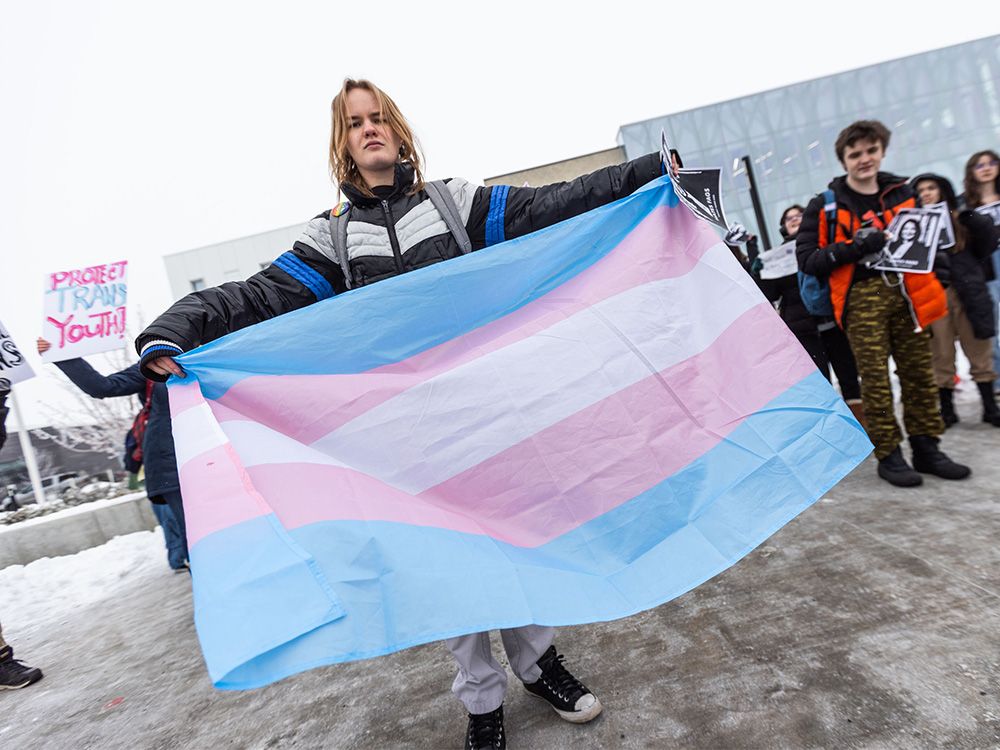
Alberta’s proposed policies targeting transgender youth have drawn criticism from parents and LGTBQ+ advocates, along with questions about their legality.
Premier Danielle Smith on Jan. 31 introduced new directives that restrict access to hormone therapy for children aged 15 and under, require parental consent if students below 15 wish to alter their names or pronouns, ban transgender female athletes from competing in women’s and girls’ sports, and mandate an opt-in system for sexual education.
Meanwhile, LGBTQ+ advocacy groups Egale Canada and Skipping Stones have vowed to take legal action against the potential rules slated to take effect in the fall.
Postmedia Calgary spoke to two legal experts on how the issue could unfold in the courts.
Judicial review
Anyone seeking legal recourse will have to seek a court injunction to halt the policies before asking for a judicial review, said Florence Ashley, a law professor at the University of Alberta who signed an open letter against Alberta’s proposed directives.
A judicial review would examine the constitutionality of a rule imposed by an authority that has been accused of unfairly exercising its power.
A judge recently ruled that a Saskatchewan law requiring parental consent for children under 16 who want to change their names or pronouns at school could be further challenged in court.
But Alberta’s more sweeping policies make them trickier than Saskatchewan’s rules around parental consent, said Jennifer Koshan, a law professor at the University of Calgary who also supported the open letter.
The contest should be a “straightforward affair,” said Ashley. “There is a pretty strong view in the legal community that policies like these aren’t on a very solid footing when it comes to the Charter,” she added.
Ashley argued the rules breach sections of the Charter that protect freedom of expression; the right to life, liberty and security of the person; protection against cruel and unusual treatment; and right to equality.
If convinced the rule infringes on rights, the courts will apply what is called an Oakes test, an analysis of whether the law is justified despite the infringement and if the law’s effects are proportional to its benefits.
However, Ashley believes a judicial review, which could last between several months and years, would most likely rule in favour of advocacy groups.
Enter notwithstanding clause
However, most of these rights can be overridden if the Alberta government chooses to invoke the notwithstanding clause, which shields the laws from judicial scrutiny for five years.
However, provincial governments have increasingly used the loophole to pass policies while dodging critical examination.
Ontario enacted the provision twice, first to limit Toronto city council to curb third-party election financing in 2021. Quebec invoked the clause in 2022 while passing Bill 21, which restricts public sector workers from wearing religious symbols on the job, and for the province’s language law, Bill 96.
Saskatchewan invoked the clause last year to pass its law requiring parental consent for a student under 16 to change their name or pronoun, though that still faces a new court challenge.
Ashley said she couldn’t think of a precedent where the usage of the notwithstanding clause was successfully challenged. (Quebec’s ban on religious symbols is currently being tested in its courts.)
Division of power
A challenge would depend on how Alberta frames the consequences of violating its legislation, such as the ban on hormone therapy. If certain penalties are attached to the breach, then the policy could look like criminal law, said Ashley, a power that rests solely with the federal government.
“If these policies either step over onto a federal law or federal jurisdiction, then it would be possible to strike them down,” Ashley said. One precedent is the 1983 case of R v. Morgantaler, which ruled against a law in Ontario preventing access to abortions.
Equality rights
Section 28 of the Charter requires that guaranteed rights and freedoms be implemented without discrimination between the sexes, despite the notwithstanding clause.
“Some people have argued that section 28 could also be interpreted to apply to gender minorities,” Koshan said. “If the government was targeting trans and gender diverse people, section 28 might protect them.”
Other parts of the Constitution
The notwithstanding clause can only override certain sections within the Charter of Rights, not provisions mentioned in the Constitution.
“There’s case law around the implied Bill of Rights and the unwritten principles of the Constitution, and whether they pertain to this cause is quite underexplored, because, well, the reality is, we’ve never really had this broader use of the notwithstanding clause,” said Ashley.



